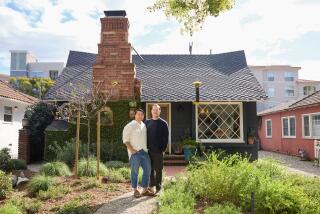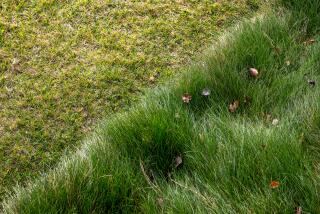Good Pathway Plants
- Share via
For best results when planting a pathway, amend soil by 25% to 50% with planter mix, suggests Ted Mayeda, owner of M&M; Nursery in Orange. Until they’re established, water plants before they dry out, but be careful not to overwater.
The following low-growing plants are perfect next to or within a pathway. Ground covers listed take light foot traffic.
* Alyssum: Prostrate, trailing plant with almost continuous clusters of flowers in purple, lavender, and most commonly white. Full sun to shade.
* Aptenia: Trailing ice plant with bright red flowers. Full sun.
* Baby’s tears: Creeping plant with tiny round leaves makes compact, lush green mat. Shade inland; part-sun on coast.
* Blue star creeper (Laurentia fluviatilis): Low-growing ground cover with small, pointed, oval leaves resembling a baby’s tears. Plant covered with blue, starlike flowers in late spring and summer. Full sun or partial shade.
* Campanula: There are many species of low-growing campanula perfect for pathways. The flowers are usually bell-shaped, but some are star-shaped, cup-shaped and round or flat. Flowers generally bloom from spring to fall and usually come in blue, lavender, violet, purple and white. Shade inland; some sun on the coast.
* Carex berggrenii: Ornamental clumping grass that grows 2 to 4 inches high. Blue-green metallic gray or reddish brown foliage. Full sun to part shade.
* Corsican mint: Low-growing, matting mint with tiny, round, bright green leaves and light purple flowers in summer. Gives off fragrance when stepped on. Sun or partial shade.
* Erodium: Low-growing relative of the geranium, generally reaching 3 to 6 inches high. Flowers spring through fall in a variety of colors, including white, rose-pink and white with lavender veins. Part shade (except for E. reichardii, which requires full shade).
* Ivy: Many of the low-growing, small-leaved forms of ivy make good pathway plants, especially needlepoint ivy, which stays compact. Most ivy takes sun or part shade.
* Korean grass (Zoysia tenuifolia): Creeping, fine-textured, mounding grass gives mossy effect. Needs little water once established. Full sun to light shade.
* Mondo grass (O. japonicus ‘Kyoto Dwarf’): Dark green, straplike 4- to 6-inch-long leaves in tight clumps. Takes full sun to part shade.
* Moss (Irish and Scotch): Good ground covers of dense, mosslike foliage, especially along the coast. Useful for filling in gaps between stepping stones. Irish moss is generally green and Scotch moss golden-green. Full sun to partial shade.
* Pennyroyal: Creeping, low-growing mint with round, 1-inch leaves and small lavender flowers. Strong mint flavor and fragrance. Needs moist site and shade to partial sun.
* Thyme: There are several low-growing thyme that make good ground covers. ‘Doone Valley’ is an unusual matting thyme with dark green foliage mottled with light gold. It grows just 3 inches tall, has red-purple flowers in summer and releases a lemon scent when stepped on.
Woolly thyme creates a flat to undulating mat of 2- to 3-inch high small, gray woolly foliage. Elfin thyme is a tight matting plant with green foliage and soft pink flowers in summer. All thymes take sun to partial shade.






